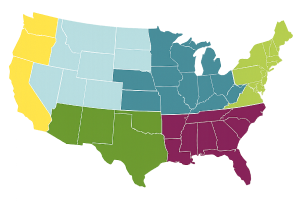Massachusetts Native Plants, State Flower & State Bird
Posted By American Meadows Content Team on Sep 27, 2012 · Revised on Oct 26, 2025

Knowing your location helps us recommend plants that will thrive in your climate, based on your Growing Zone.
Posted By American Meadows Content Team on Sep 27, 2012 · Revised on Oct 26, 2025
Native plants are adaptable, low-maintenance, and beautiful. They are the best choice for habitat-friendly gardens and thriving ecosystems. Find top picks for native plants in your state - and learn about your state bird and state flowers!
Follow Along With More Of Our Guides
Hello native plant enthusiasts! In the list below, you will find popular native plants and wildflower seeds, available from American Meadows, that have a native distribution in your state. You’ll also find information about your state bird, state flower, and state wildflower!
Grow our Native Northeast Wildflower Seed Mix
Virginia Bluebells (Mertensia virginica)
Showy Goldenrod (Solidago speciosa)
Wrinkleleaf Goldenrod (Solidago rugosa)
Perennial Lupine (Lupinus perennis)
Black Eyed Susan (Rudbeckia fulgida)
Black Eyed Susan or Gloriosa Daisy (Rudbeckia hirta)
Pale Purple Coneflower (Echinacea pallida)
Yellow Prairie Coneflower (Ratibida columnifera)
Gray Headed Coneflower (Ratibida pinnata)
Butterfly Weed (Asclepias tuberosa)
Swamp Milkweed (Asclepias incarnata)
Common Milkweed (Asclepias syriaca)
White Trillium (Trillium grandiflorum)
Red Trillium (Trillium erectum)
Painted Trillium (Trillium undulatum)
Long Beaked Sedge (Carex sprengelii)
White Tinged Sedge (Carex albicans)
Appalachian Sedge (Carex appalachia)
Firewheel (Gaillardia pulchella)
Blanket Flower (Gaillardia aristata)
Lanceleaf Coreopsis (Coreopsis lanceolata)
Pink Coreopsis (Coreopsis rosea)
Wild Bergamot (Monarda fistulosa)
Wild Geranium (Geranium maculatum)
Elderberry (Sambucus canadensis)
Black Cohosh (Actaea racemosa)
Phlox subulata (Creeping Phlox)
Obedient Plant (Physostegia virginiana)
Red Cardinal Flower (Lobelia cardinalis)
Blazing Star (Liatris spicata)
Prairie Blazing Star (Liatris pycnostachya)
Meadow Anemone (Anemone canadensis)
Lacy Phacelia (Phacelia tanacetifolia)
Bottlebrush Grass (Elymus hystrix)
Muhly Grass (Muhlenbergia capillaris)
Big Bluestem (Andropogon gerardii)
Little Bluestem (Schizachyrium scoparium)
Tufted Hair Grass (Deschampsia cespitosa)
Northern Sea Oats (Chasmanthium latifolium)
Yellow Prairie Grass (Sorghastrum nutans)
Wild Strawberry (Fragaria virginiana)
Lowbush Blueberry (Vaccinium angustifolium)
Smooth Blue Aster (Symphyotrichum laeve)
New England Aster (Symphyotrichum novae-angliae)
Ironweed (Vernonia fasciculata)
Common White Yarrow (Achillea millefolium)
Heliopsis (Heliopsis helianthoides)

Black-Capped Chickadee ~ Parus atricapillus
In summer, the Black-Capped Chickadee feeds mainly on insects, seeds, wild berries, and other fruits. Because he can alight upside down on the underside of a twig and perform similar gymnastics, he often finds food missed by other birds. The Chickadee ranks as the most trusting and least pugnacious bird among those who visit feeding stations. Northern shrikes and fast-moving hawks prey on Chickadees, but the little birds often escape by quickly diving for cover in a network of evergreen twigs.
Mayflower ~ Epigaea repens
It seems more than likely that the Mayflower derives its name from the ship that brought the Pilgrims to America. After what must have been the most harrowing winter of their lives, the Pilgrims came upon this delicate, fragrant harbinger of spring. In affectionate memory of their ship, they called it the Mayflower. The Mayflower (or trailing arbutus as it is also known) often blossoms before the snow has melted, lives close to the earth, spreads in thick mats, and prefers either sandy soil in woods or a home among rocks under pine trees.
From The Wildflowers of the 50 States U.S. stamps issued July 24, 1992:

